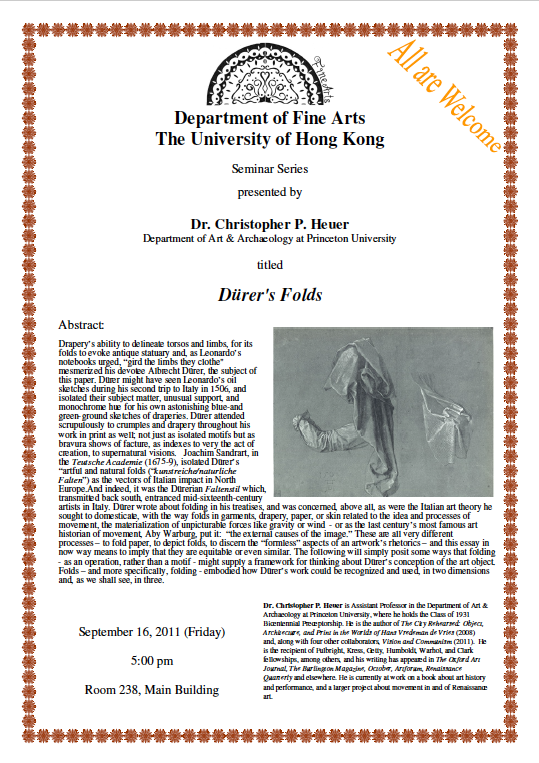

Durer’s Folds
September 16, 2011 @ 5:00 pm - 6:30 pm
Durer’s Folds
Date: 16 September 2011 (Friday)
Time: 5:00pm
Venue: Room 2.38, Main Building, HKU
Drapery’s ability to delineate torsos and limbs, for its folds to evoke antique statuary and, as Leonardo’s notebooks urged, “gird the limbs they clothe” mesmerized his devotee Albrecht Dürer, the subject of this paper. Dürer might have seen Leonardo’s oil sketches during his second trip to Italy in 1506, and isolated their subject matter, unusual support, and monochrome hue for his own astonishing blue-and green-ground sketches of draperies. Dürer attended scrupulously to crumples and drapery throughout his work in print as well; not just as isolated motifs but as bravura shows of facture, as indexes to very the act of creation, to supernatural visions. Joachim Sandrart, in the Teutsche Academie (1675-9), isolated Dürer’s “artful and natural folds (“kunstreiche/naturliche Falten”) as the vectors of Italian impact in North Europe. And indeed, it was the Dürerian Faltenstil which, transmitted back south, entranced mid-sixteenth-century artists in Italy. Dürer wrote about folding in his treatises, and was concerned, above all, as were the Italian art theory he sought to domesticate, with the way folds in garments, drapery, paper, or skin related to the idea and processes of movement, the materialization of unpicturable forces like gravity or wind – or as the last century’s most famous art historian of movement, Aby Warburg, put it: “the external causes of the image.” These are all very different processes – to fold paper, to depict folds, to discern the “formless” aspects of an artwork’s rhetorics – and this essay in now way means to imply that they are equitable or even similar. The following will simply posit some ways that folding – as an operation, rather than a motif – might supply a framework for thinking about Dürer’s conception of the art object. Folds – and more specifically, folding – embodied how Dürer’s work could be recognized and used, in two dimensions and, as we shall see, in three.
Speaker: Christopher P. Heuer
Dr. Christopher P. Heuer is Assistant Professor in the Department of Art & Archaeology at Princeton University, where he holds the Class of 1931 Bicentennial Preceptorship. He is the author of The City Rehearsed: Object, Architecture, and Print in the Worlds of Hans Vredeman de Vries (2008) and, along with four other collaborators, Vision and Communism (2011). He is the recipient of Fulbright, Kress, Getty, Humboldt, Warhol, and Clark fellowships, among others, and his writing has appeared in The Oxford Art Journal, The Burlington Magazine, October, Artforum, Renaissance Quarterly and elsewhere. He is currently at work on a book about art history and performance, and a larger project about movement in and of Renaissance art.



Find us on…